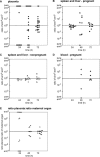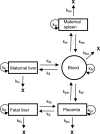Listeria monocytogenes traffics from maternal organs to the placenta and back
- PMID: 16846254
- PMCID: PMC1483233
- DOI: 10.1371/journal.ppat.0020066
Listeria monocytogenes traffics from maternal organs to the placenta and back
Erratum in
- PLoS Pathog. 2006 Jul;2(7):e80
Abstract
Infection with Listeria monocytogenes is a significant health problem during pregnancy. This study evaluates the role of trafficking between maternal organs and placenta in a pregnant guinea pig model of listeriosis. After intravenous inoculation of guinea pigs, the initial ratio of bacteria in maternal organs to placenta was 10(3)-10(4):1. Rapid increase of bacteria in the placenta changed the ratio to 1:1 after 24 h. Utilizing two wild-type strains, differentially marked by their susceptibility to erythromycin, we found that only a single bacterium was necessary to cause placental infection, and that L. monocytogenes trafficked from maternal organs to the placenta in small numbers. Surprisingly, bacteria trafficked in large numbers from the placenta to maternal organs. Bacterial growth, clearance, and transport between organs were simulated with a mathematical model showing that the rate of bacterial clearance relative to the rate of bacterial replication in the placenta was sufficient to explain the difference in the course of listeriosis in pregnant versus nonpregnant animals. These results provide the basis for a new model where the placenta is relatively protected from infection. Once colonized, the placenta becomes a nidus of infection resulting in massive reseeding of maternal organs, where L. monocytogenes cannot be cleared until trafficking is interrupted by expulsion of the infected placental tissues.
Conflict of interest statement
Figures






References
-
- Teberg AJ, Yonekura ML, Salminen C, Pavlova Z. Clinical manifestations of epidemic neonatal listeriosis. Pediatr Infect Dis J. 1987;6:817–820. - PubMed
-
- Mylonakis E, Paliou M, Hohmann EL, Calderwood SB, Wing EJ. Listeriosis during pregnancy: A case series and review of 222 cases. Medicine (Baltimore) 2002;81:260–269. - PubMed
-
- Medawar PB. Some immunological and endocrinological problems raised by the evolution of viviparity in vertebrates. Symp Soc Exp Biol. 1953;7:320–338.
-
- Wegmann TG, Lin H, Guilbert L, Mosmann TR. Bidirectional cytokine interactions in the maternal-fetal relationship: Is successful pregnancy a TH2 phenomenon? Immunol Today. 1993;14:353–356. - PubMed
-
- Raghupathy R. Pregnancy: Success and failure within the Th1/Th2/Th3 paradigm. Semin Immunol. 2001;13:219–227. - PubMed

